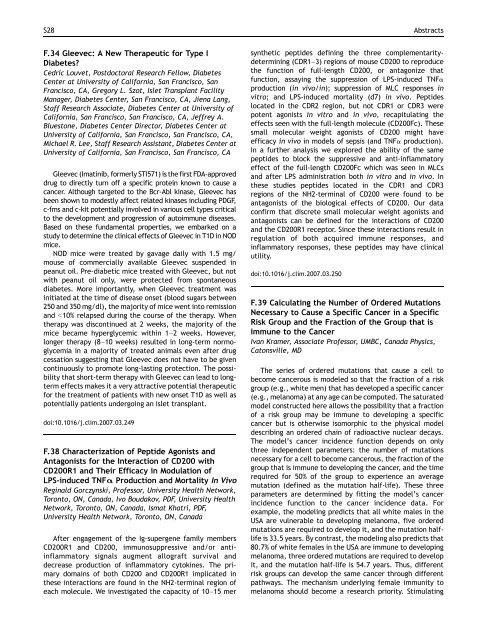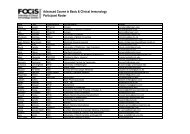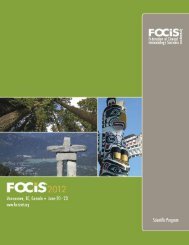Oral Presentations - Federation of Clinical Immunology Societies
Oral Presentations - Federation of Clinical Immunology Societies
Oral Presentations - Federation of Clinical Immunology Societies
You also want an ePaper? Increase the reach of your titles
YUMPU automatically turns print PDFs into web optimized ePapers that Google loves.
S28 Abstracts<br />
F.34 Gleevec: A New Therapeutic for Type I<br />
Diabetes?<br />
Cedric Louvet, Postdoctoral Research Fellow, Diabetes<br />
Center at University <strong>of</strong> California, San Francisco, San<br />
Francisco, CA, Gregory L. Szot, Islet Transplant Facility<br />
Manager, Diabetes Center, San Francisco, CA, Jiena Lang,<br />
Staff Research Associate, Diabetes Center at University <strong>of</strong><br />
California, San Francisco, San Francisco, CA, Jeffrey A.<br />
Bluestone, Diabetes Center Director, Diabetes Center at<br />
University <strong>of</strong> California, San Francisco, San Francisco, CA,<br />
Michael R. Lee, Staff Research Assistant, Diabetes Center at<br />
University <strong>of</strong> California, San Francisco, San Francisco, CA<br />
Gleevec (Imatinib, formerly STI571) is the first FDA-approved<br />
drug to directly turn <strong>of</strong>f a specific protein known to cause a<br />
cancer. Although targeted to the Bcr-Abl kinase, Gleevec has<br />
been shown to modestly affect related kinases including PDGF,<br />
c-fms and c-kit potentially involved in various cell types critical<br />
to the development and progression <strong>of</strong> autoimmune diseases.<br />
Based on these fundamental properties, we embarked on a<br />
study to determine the clinical effects <strong>of</strong> Gleevec in T1D in NOD<br />
mice.<br />
NOD mice were treated by gavage daily with 1.5 mg/<br />
mouse <strong>of</strong> commercially available Gleevec suspended in<br />
peanut oil. Pre-diabetic mice treated with Gleevec, but not<br />
with peanut oil only, were protected from spontaneous<br />
diabetes. More importantly, when Gleevec treatment was<br />
initiated at the time <strong>of</strong> disease onset (blood sugars between<br />
250 and 350 mg/dl), the majority <strong>of</strong> mice went into remission<br />
and b10% relapsed during the course <strong>of</strong> the therapy. When<br />
therapy was discontinued at 2 weeks, the majority <strong>of</strong> the<br />
mice became hyperglycemic within 1–2 weeks. However,<br />
longer therapy (8–10 weeks) resulted in long-term normoglycemia<br />
in a majority <strong>of</strong> treated animals even after drug<br />
cessation suggesting that Gleevec does not have to be given<br />
continuously to promote long-lasting protection. The possibility<br />
that short-term therapy with Gleevec can lead to longterm<br />
effects makes it a very attractive potential therapeutic<br />
for the treatment <strong>of</strong> patients with new onset T1D as well as<br />
potentially patients undergoing an islet transplant.<br />
doi:10.1016/j.clim.2007.03.249<br />
F.38 Characterization <strong>of</strong> Peptide Agonists and<br />
Antagonists for the Interaction <strong>of</strong> CD200 with<br />
CD200R1 and Their Efficacy in Modulation <strong>of</strong><br />
LPS-induced TNFα Production and Mortality In Vivo<br />
Reginald Gorczynski, Pr<strong>of</strong>essor, University Health Network,<br />
Toronto, ON, Canada, Ivo Boudakov, PDF, University Health<br />
Network, Toronto, ON, Canada, Ismat Khatri, PDF,<br />
University Health Network, Toronto, ON, Canada<br />
After engagement <strong>of</strong> the Ig-supergene family members<br />
CD200R1 and CD200, immunosuppressive and/or antiinflammatory<br />
signals augment allograft survival and<br />
decrease production <strong>of</strong> inflammatory cytokines. The primary<br />
domains <strong>of</strong> both CD200 and CD200R1 implicated in<br />
these interactions are found in the NH2-terminal region <strong>of</strong><br />
each molecule. We investigated the capacity <strong>of</strong> 10–15 mer<br />
synthetic peptides defining the three complementaritydetermining<br />
(CDR1–3) regions <strong>of</strong> mouse CD200 to reproduce<br />
the function <strong>of</strong> full-length CD200, or antagonize that<br />
function, assaying the suppression <strong>of</strong> LPS-induced TNFα<br />
production (in vivo/in); suppression <strong>of</strong> MLC responses in<br />
vitro; and LPS-induced mortality (d7) in vivo. Peptides<br />
located in the CDR2 region, but not CDR1 or CDR3 were<br />
potent agonists in vitro and in vivo, recapitulating the<br />
effects seen with the full-length molecule (CD200Fc). These<br />
small molecular weight agonists <strong>of</strong> CD200 might have<br />
efficacy in vivo in models <strong>of</strong> sepsis (and TNFα production).<br />
In a further analysis we explored the ability <strong>of</strong> the same<br />
peptides to block the suppressive and anti-inflammatory<br />
effect <strong>of</strong> the full-length CD200Fc which was seen in MLCs<br />
and after LPS administration both in vitro and in vivo. In<br />
these studies peptides located in the CDR1 and CDR3<br />
regions <strong>of</strong> the NH2-terminal <strong>of</strong> CD200 were found to be<br />
antagonists <strong>of</strong> the biological effects <strong>of</strong> CD200. Our data<br />
confirm that discrete small molecular weight agonists and<br />
antagonists can be defined for the interactions <strong>of</strong> CD200<br />
and the CD200R1 receptor. Since these interactions result in<br />
regulation <strong>of</strong> both acquired immune responses, and<br />
inflammatory responses, these peptides may have clinical<br />
utility.<br />
doi:10.1016/j.clim.2007.03.250<br />
F.39 Calculating the Number <strong>of</strong> Ordered Mutations<br />
Necessary to Cause a Specific Cancer in a Specific<br />
Risk Group and the Fraction <strong>of</strong> the Group that is<br />
Immune to the Cancer<br />
Ivan Kramer, Associate Pr<strong>of</strong>essor, UMBC, Canada Physics,<br />
Catonsville, MD<br />
The series <strong>of</strong> ordered mutations that cause a cell to<br />
become cancerous is modeled so that the fraction <strong>of</strong> a risk<br />
group (e.g., white men) that has developed a specific cancer<br />
(e.g., melanoma) at any age can be computed. The saturated<br />
model constructed here allows the possibility that a fraction<br />
<strong>of</strong> a risk group may be immune to developing a specific<br />
cancer but is otherwise isomorphic to the physical model<br />
describing an ordered chain <strong>of</strong> radioactive nuclear decays.<br />
The model’s cancer incidence function depends on only<br />
three independent parameters: the number <strong>of</strong> mutations<br />
necessary for a cell to become cancerous, the fraction <strong>of</strong> the<br />
group that is immune to developing the cancer, and the time<br />
required for 50% <strong>of</strong> the group to experience an average<br />
mutation (defined as the mutation half-life). These three<br />
parameters are determined by fitting the model’s cancer<br />
incidence function to the cancer incidence data. For<br />
example, the modeling predicts that all white males in the<br />
USA are vulnerable to developing melanoma, five ordered<br />
mutations are required to develop it, and the mutation halflife<br />
is 33.5 years. By contrast, the modeling also predicts that<br />
80.7% <strong>of</strong> white females in the USA are immune to developing<br />
melanoma, three ordered mutations are required to develop<br />
it, and the mutation half-life is 54.7 years. Thus, different<br />
risk groups can develop the same cancer through different<br />
pathways. The mechanism underlying female immunity to<br />
melanoma should become a research priority. Stimulating




